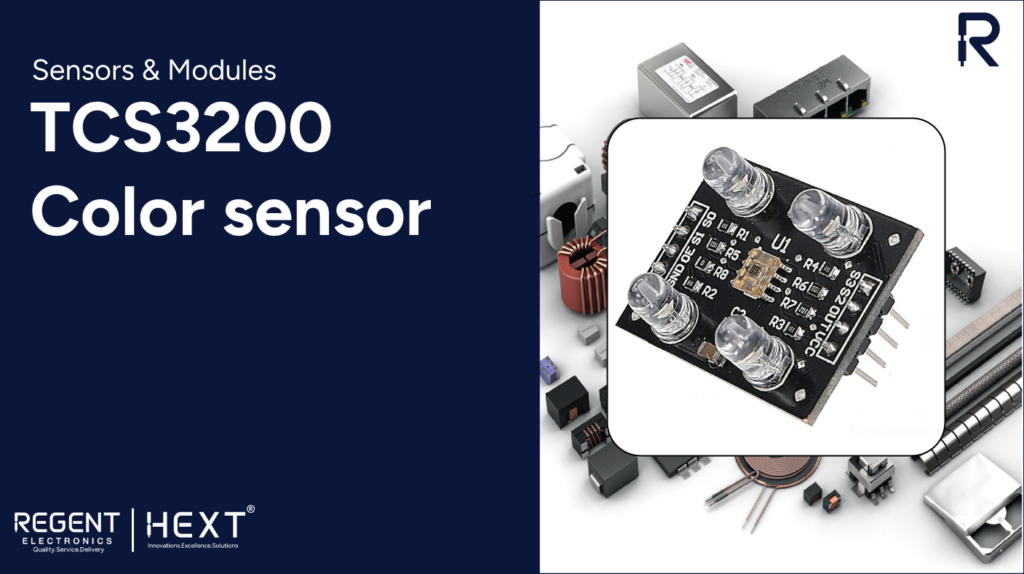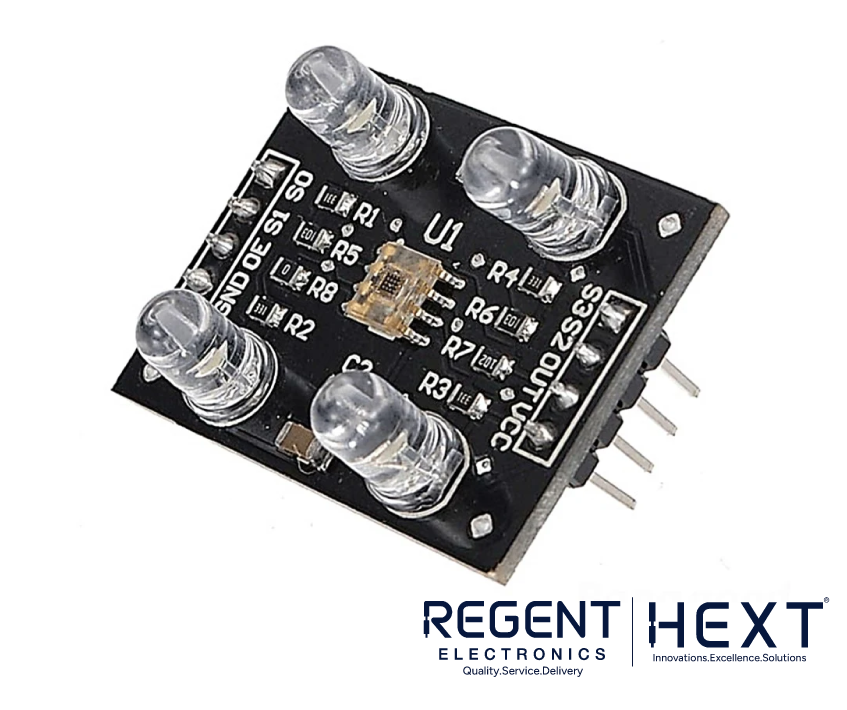
TCS3200 Color Sensor: Revolutionizing Color Detection and Applications

The TCS3200 Color Sensor is an essential component for various applications that require precise color recognition. It uses the primary colors—red, green, and blue—to form a vast spectrum of colors, each with its unique wavelength and intensity. The TCS3200 is capable of detecting these colors accurately, making it an ideal tool for a range of industries including health, process control, and color sorting operations.
At Regent Electronics, we offer high-quality TCS3200 color sensor modules that provide reliable performance for your DIY projects, automation systems, and professional applications.
How Does the TCS3200 Color Sensor Work?
The TCS3200 Color Sensor operates by emitting white light to illuminate a surface, then using three specific filters to detect the red, green, and blue wavelengths. These wavelengths correspond to 580nm, 540nm, and 450nm, respectively. The sensor converts the reflected light into a voltage signal, which can then be read by a microcontroller like Arduino or NodeMCU.
The sensor features an 8×8 photodiode array, totaling 64 photodiodes. Of these, 16 photodiodes are responsible for detecting red, 16 for green, 16 for blue, and the remaining 16 are clear photodiodes, meaning they do not detect any specific color. By processing the data from these photodiodes, the sensor can accurately identify the color of the surface it is pointing to.
How to Use the TCS3200 Color Sensor Module:
Here’s a simple guide to setting up and using the TCS3200 Color Sensor with an Arduino.

(i) Wiring the Module:
- Connect the 5V pin of the module to the 5V pin on the Arduino.
- Connect the GND pin of the module to the GND pin on the Arduino.
- Connect the OUT pin of the module to pin 8 on the Arduino.
- Connect S3 of the module to pin 6 on the Arduino.
- Connect S2 of the module to pin 7 on the Arduino.
- Connect S1 of the module to pin 5 on the Arduino.
- Connect S0 of the module to pin 4 on the Arduino.
(ii) Code for Color Detection:
Before uploading the code to the Arduino, you need to calibrate the TCS3200 Color Sensor. This is done using the pulseIn() function to measure the frequency of different colors detected by the sensor. Once calibrated, you can use the following code to detect and display the detected colors on the serial monitor. For even easier color detection, you can also use an RGB LED to visually represent the color the sensor detects.
Code for Color Detection:
cpp
CopyEdit
#define S0 4
#define S1 5
#define S2 6
#define S3 7
#define sensorOut 8
int redFrequency = 0;
int greenFrequency = 0;
int blueFrequency = 0;
void setup() {
pinMode(S0, OUTPUT);
pinMode(S1, OUTPUT);
pinMode(S2, OUTPUT);
pinMode(S3, OUTPUT);
pinMode(sensorOut, INPUT);
digitalWrite(S0, HIGH);
digitalWrite(S1, LOW);
Serial.begin(9600);
}
void loop() {
digitalWrite(S2, LOW);
digitalWrite(S3, LOW);
redFrequency = pulseIn(sensorOut, LOW);
delay(100);
digitalWrite(S2, LOW);
digitalWrite(S3, HIGH);
blueFrequency = pulseIn(sensorOut, LOW);
if (redFrequency > 25 && redFrequency < 77) {
Serial.println(“RED COLOR DETECTED”);
}
else if (blueFrequency > 25 && blueFrequency < 77) {
Serial.println(“BLUE COLOR DETECTED”);
}
else if (greenFrequency > 25 && greenFrequency < 77) {
Serial.println(“GREEN COLOR DETECTED”);
}
else {
Serial.println(“NO COLOR DETECTED”);
}
}
This code sets the frequency scaling to 20%, then uses individual photodiodes to detect red, blue, and green colors. If the frequency value of a color is within a specific range, it is identified and displayed on the serial monitor.
Applications of the TCS3200 Color Sensor:
The TCS3200 Color Sensor is highly versatile and is widely used in various fields. Some notable applications include:
- Health & Fitness Systems: Monitoring and analyzing color changes in fitness equipment, such as heart rate monitors, for health assessments.
- Light Color Temperature Measurement: Measuring and adjusting light color for improved visual experience in photography, design, and lighting systems.
- Process Control for Printing: Ensuring consistent color output in printing processes, including quality control and color matching.
- Color Detection and Sorting Operations: Sorting colored objects in industrial automation systems, such as sorting products by color on assembly lines.
Why Choose Regent Electronics for TCS3200 Color Sensors?
At Regent Electronics, we offer high-quality TCS3200 Color Sensor Modules designed to meet the needs of hobbyists, engineers, and professionals. Our modules are easy to integrate with Arduino and other microcontrollers, making them perfect for your DIY projects, automation systems, and industrial applications.
Explore our range of TCS3200 Color Sensor Modules today and bring accurate color detection to your projects. Whether you’re building a color sorting machine, health monitoring system, or experimenting with new ideas, the TCS3200 offers reliable, precise color recognition.
Visit Regent Electronics to discover more innovative sensors and components for your electronics projects and applications!
